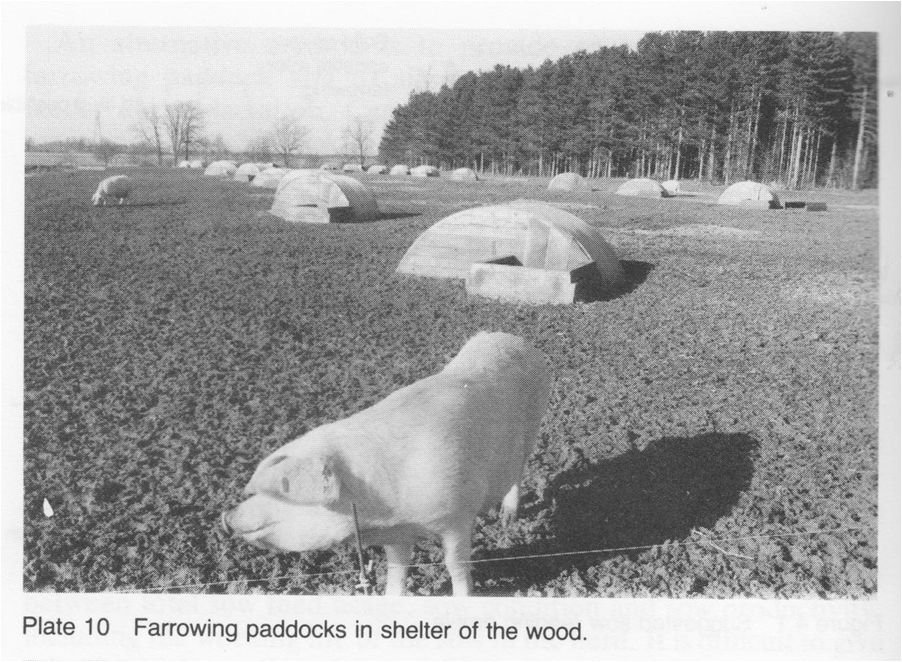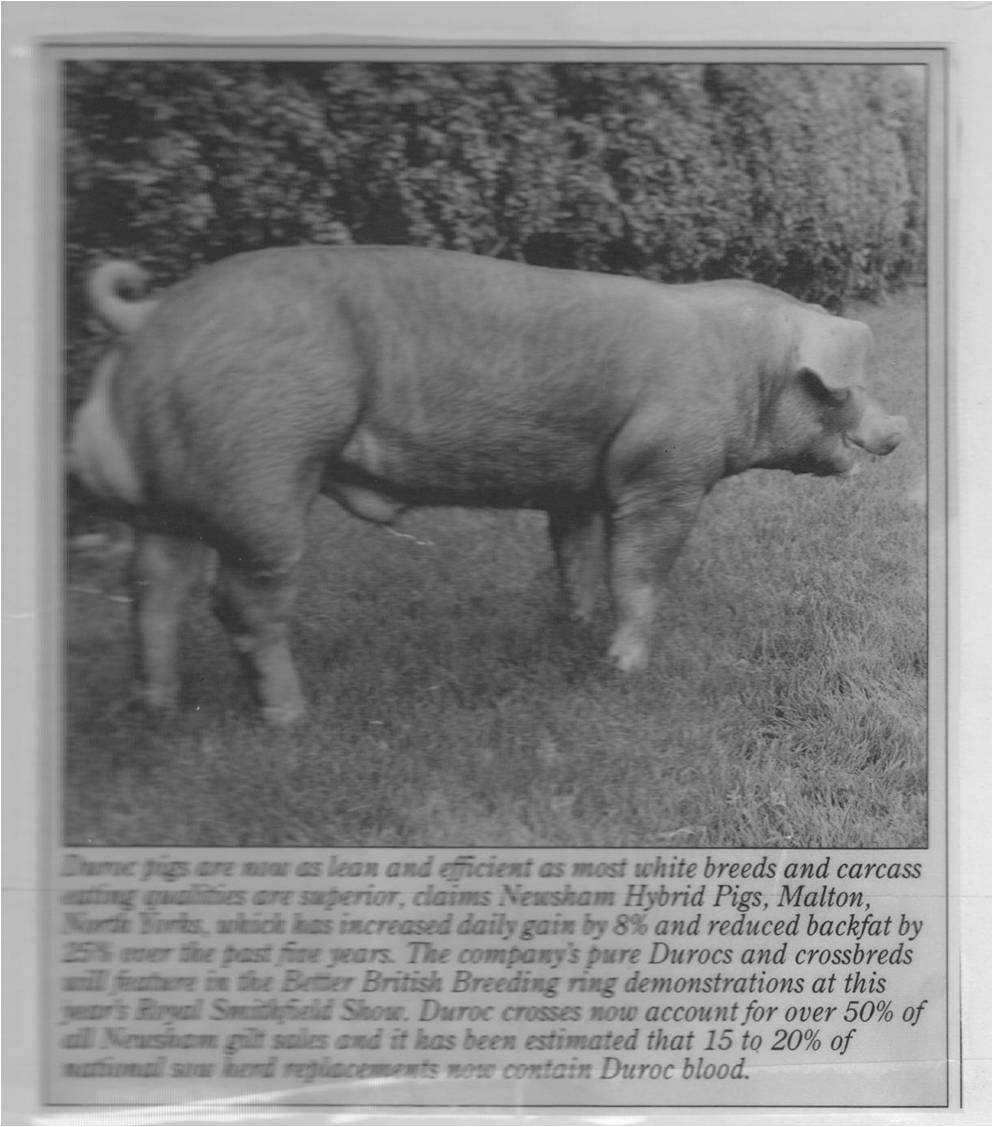 Scanned from Outdoor Pig Production by Keith Thornton
Scanned from Outdoor Pig Production by Keith ThorntonFrom the start of our whole farming adventure I’ve been keen on pigs. Pigs are the unsung hero of the farm. They eat the scraps, they eat the whey, they till the land (i.e. cause a huge mess and dig mud wallows), they have impressive intelligence, and, most importantly, they make bacon! For whatever reason, when we visit farms I always love the pigs and I’m really looking forward to having a herd.
So, I’ve been reading a lot about outdoor pig production. I guess I should say “a lot of what I can find”, which isn’t a whole lot to begin with. One of the most promising books I’ve found is called Outdoor Pig Production, by Keith Thornton and it just came in the mail this week. I found a copy from someone in the UK and it even has an old note and a newspaper clipping taped to the inside with a picture of a Duroc and the breed’s benefits:
In the Introduction Thornton details a little bit of porcine history. In the United States he mentions that pigs initially found solace in the woodlands and hills along the Atlantic seaboard. The pigs were shipped from Europe with explorers, making their way to the Caribbean and eventually the U.S. That sounds pretty reasonable to me. Pigs on a ship could be mayhem, but I’m sure they were penned and everything was generally under control. It’s what Thornton talks about next that really threw me through a loop. “The real advance in American pig production took place in the first half of the nineteenth century, as the settlers moved west and took their pigs with them. The pigs which trekked into the unexplored territories with the frontiersmen were basically ‘wood’ pigs, because they were able to feed by foraging in the woods and forests.” Ok. Sure, pigs could forage, but how the heck were they herded west!? I mean, we hear horror stories of moving pigs from one side of a farm to another, let alone from the Atlantic seaboard halfway across the country!
Thornton goes on to say, “The route to the West lay through Ohio, and Cincinnati was an early centre of slaughtering and processing... Chicago then became ‘pork butcher to the world’.” Wow, I can't imagine herding pigs from the East coast to Chicago. It had to have taken many months, which would've meant dealing with all kinds of adverse weather conditions. I'd imagine they had some breed of herd dog to help out, such as the Catahoula Curs that are still used in Louisiana and other parts of the country to herd cattle and pigs today. The men probably had some form of whip, lasso or stick to keep 'em moving and in line. Even so, it must have been a tough task! What an experience that must have been. I wonder what the success ratio was? What percent of pigs made it? No wonder there’s wild herds of feral pigs all over the US; there’s no way humans could herd them successfully over enormous tracts of land.
Then Thornton explains the historical outdoor pig production process, “The management system by the 1940s was based on twice-yearly farrowing in march and September, or spring and fall. Farrowing took place in portable wooden huts or arks and, during gestation, groups of sows ran out at pasture or on the ground in ‘dirt lots’. The breeding programme was based on the three-breed rotational crossing system, using the Yorkshire, Duroc and Hampshire breeds. The progeny were fed ad-lib to market weight in partially enclosed yards on home-grown corn, and quite often in dirt lots out of doors. herds were frequently turned out in the autumn to graze and forage in t vast acres of maize stubbles.”
It was the harsh climate and the dramatic change in geography from woodlands to corn fields that at least partially led to the major shift toward intensive pig production indoors. Of course increasing pork demand, use of fossil fuels for transportation and many other factors contributed to the eventual sad situation that we are in today. Today's factory pig “farms” are essentially warehouses with concrete floors and gated pens as far as the eye can see. Most pigs never see the light of day, let alone a fresh field of forage to root up and mud to wallow in. Hopefully some tips in this book can help us reverse that course one pig at a time.
Thornton goes on to say, “The route to the West lay through Ohio, and Cincinnati was an early centre of slaughtering and processing... Chicago then became ‘pork butcher to the world’.” Wow, I can't imagine herding pigs from the East coast to Chicago. It had to have taken many months, which would've meant dealing with all kinds of adverse weather conditions. I'd imagine they had some breed of herd dog to help out, such as the Catahoula Curs that are still used in Louisiana and other parts of the country to herd cattle and pigs today. The men probably had some form of whip, lasso or stick to keep 'em moving and in line. Even so, it must have been a tough task! What an experience that must have been. I wonder what the success ratio was? What percent of pigs made it? No wonder there’s wild herds of feral pigs all over the US; there’s no way humans could herd them successfully over enormous tracts of land.
Then Thornton explains the historical outdoor pig production process, “The management system by the 1940s was based on twice-yearly farrowing in march and September, or spring and fall. Farrowing took place in portable wooden huts or arks and, during gestation, groups of sows ran out at pasture or on the ground in ‘dirt lots’. The breeding programme was based on the three-breed rotational crossing system, using the Yorkshire, Duroc and Hampshire breeds. The progeny were fed ad-lib to market weight in partially enclosed yards on home-grown corn, and quite often in dirt lots out of doors. herds were frequently turned out in the autumn to graze and forage in t vast acres of maize stubbles.”
It was the harsh climate and the dramatic change in geography from woodlands to corn fields that at least partially led to the major shift toward intensive pig production indoors. Of course increasing pork demand, use of fossil fuels for transportation and many other factors contributed to the eventual sad situation that we are in today. Today's factory pig “farms” are essentially warehouses with concrete floors and gated pens as far as the eye can see. Most pigs never see the light of day, let alone a fresh field of forage to root up and mud to wallow in. Hopefully some tips in this book can help us reverse that course one pig at a time.


